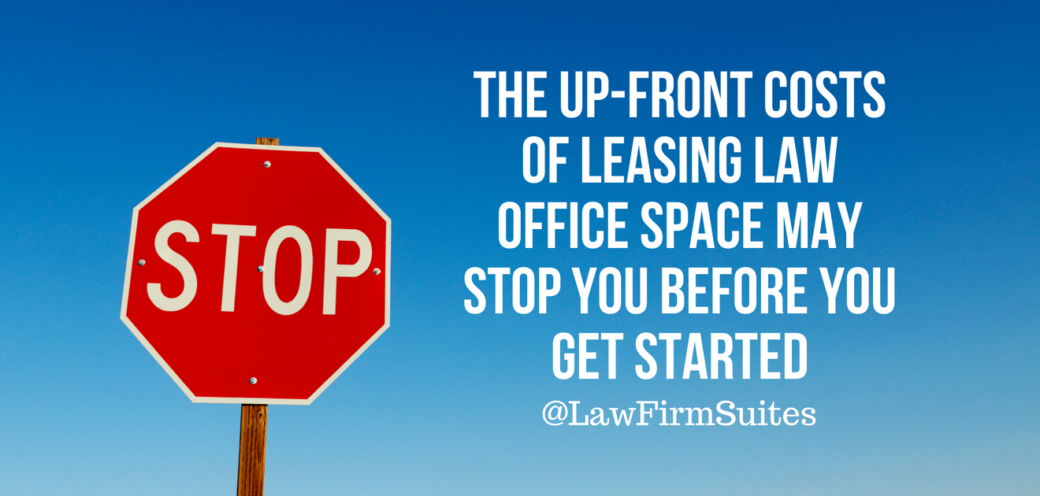One of the benefits of an office sublet or executive suite rental is the minimal up-front investment that is required to get started. Typically, all you need is the first month’s rent and a one month’s security deposit. Occasionally, there may be some minimal set-up fees related to getting your phones or Internet equipment ready for your use.
Getting into your very own leased office space, however, requires a substantial up-front cash investment that is not required in an executive suite or when you sublet an office.
Here are seven different expenses that add up quick when you decide to get your own leased office space.
Security deposit and up-front rent
On a five year plus lease, landlords want to make sure you’ll be around for the duration of the lease and that their expenses will be covered if you skip out of the lease early. Expect to pay first and last month’s rent, plus at least four months security deposit.
Build-out expenses
If you are renting a space that has not previously been built out to fit your needs, you will need a significant budget to do this. In Manhattan, for example, build-out costs in union buildings for a modest space will cost $75 – $100 per rentable square foot.
Landlords sometimes pay for or contribute to, some buildout costs – particularly with leases that are closer to 10 years in length. This being said, the landlord will not cover everything, and may be less generous when market conditions are favorable to them.
Also keep in mind that the landlord’s contribution is never free. Any contributions or build-out costs paid for by the landlord will be incorporated into your lease. You will be paying for the build-out, with interest, over the term of the lease.
IP/Network expenses
Your office will need to be cabled for internet network connections. While the pricing for network equipment has come down quite a bit, the price of copper has gone through the roof. Guess what all those Ethernet cables are made with?
In addition, you’ll need a commercial switch, a file server, commercial grade WiFi routers, a rack to mount all the equipment and a battery backup to keep it all on if the power goes out. Don’t forget to add in some kind of air conditioning system to keep all the equipment cool 24 hours a day, seven days a week.
Phone system
Your telephone system is not an area where you want to cut corners. Our profession still uses the phone for sensitive conversations relating to client matters. The middle of a settlement negotiation in a prickly case, that’s been going on for years, is most definitely not the time to be using a cheap VOIP telephone system. The last thing you want to happen is the line cutting in and out every time your administrative assistant downloads a video on Facebook. Law firm grade telecommunications systems are necessary, and, you guessed it, expensive.
Furnishings
When you sublet an office and use another firm’s common areas, you don’t think much about how many pieces of furniture are required to fill a law office. You’ll need reception desks, reception guest chairs, conference room tables and chairs, credenzas, a break room table and chairs, lamps, side tables and artwork. The list goes on. Even used furnishings get expensive.
And don’t forget to tack on the delivery charge, which will likely be 20% to 30% of the cost of the furnishings.
Copy and Mailroom
You’ll need someplace to deal with incoming and outgoing mail and make the requisite copies to ensure your law practice is successful. At the very least, you’ll need to lease a postage meter and copy machine, and get them hooked up to an Ethernet and phone connection (for faxes).
Monthly expenses will be a lot more than you think
Renting your own office space is a lot like moving from an apartment in the city to a house in the suburbs. When house hunting, how many people are amazed at how much house their current rental payment can buy, but a month after moving realize that they didn’t account for expenses that they weren’t used to paying while renting.
Property taxes add an extra $800/month. The heat that your landlord used to pay now costs you $750/ month. Mowing the lawn sounded fun until you did it for a month. Now the gardener costs $400/month. Tack on extras for homeowner’s insurance, PMI, extra commuting costs, and suddenly your monthly costs are nearly double that rental payment.
Now you can see how the up-front costs associated with leasing your own office space directly from a landlord can add up quickly. Following these expenses, a small law firm who leases an office space of approx. 1,400 sf. at $35 per sf., will have an up-front cost of about $125,000. So the next time you’re moving your law office, make sure to research office sublets or executive suite rentals as other, less expensive law office options.


